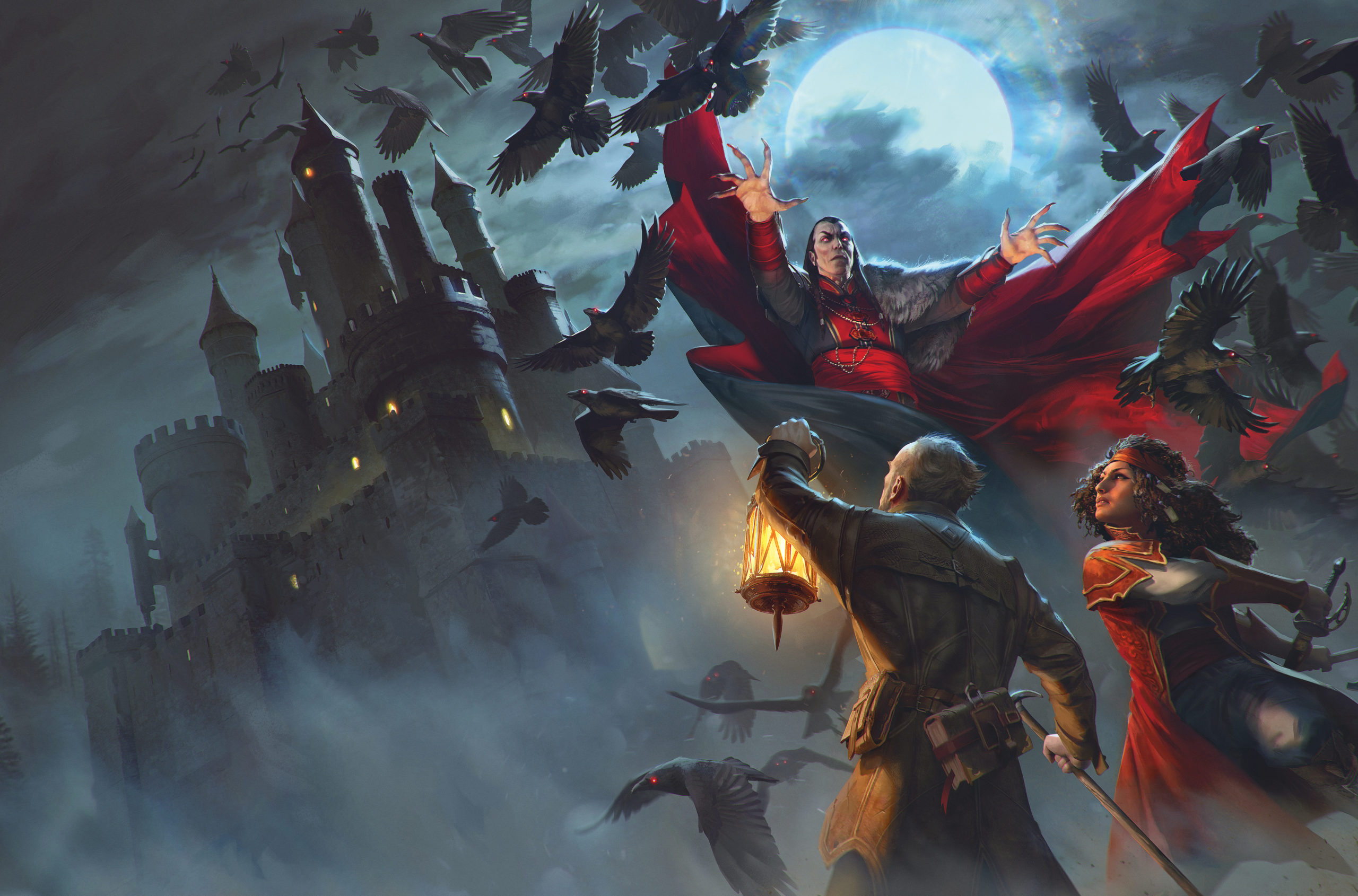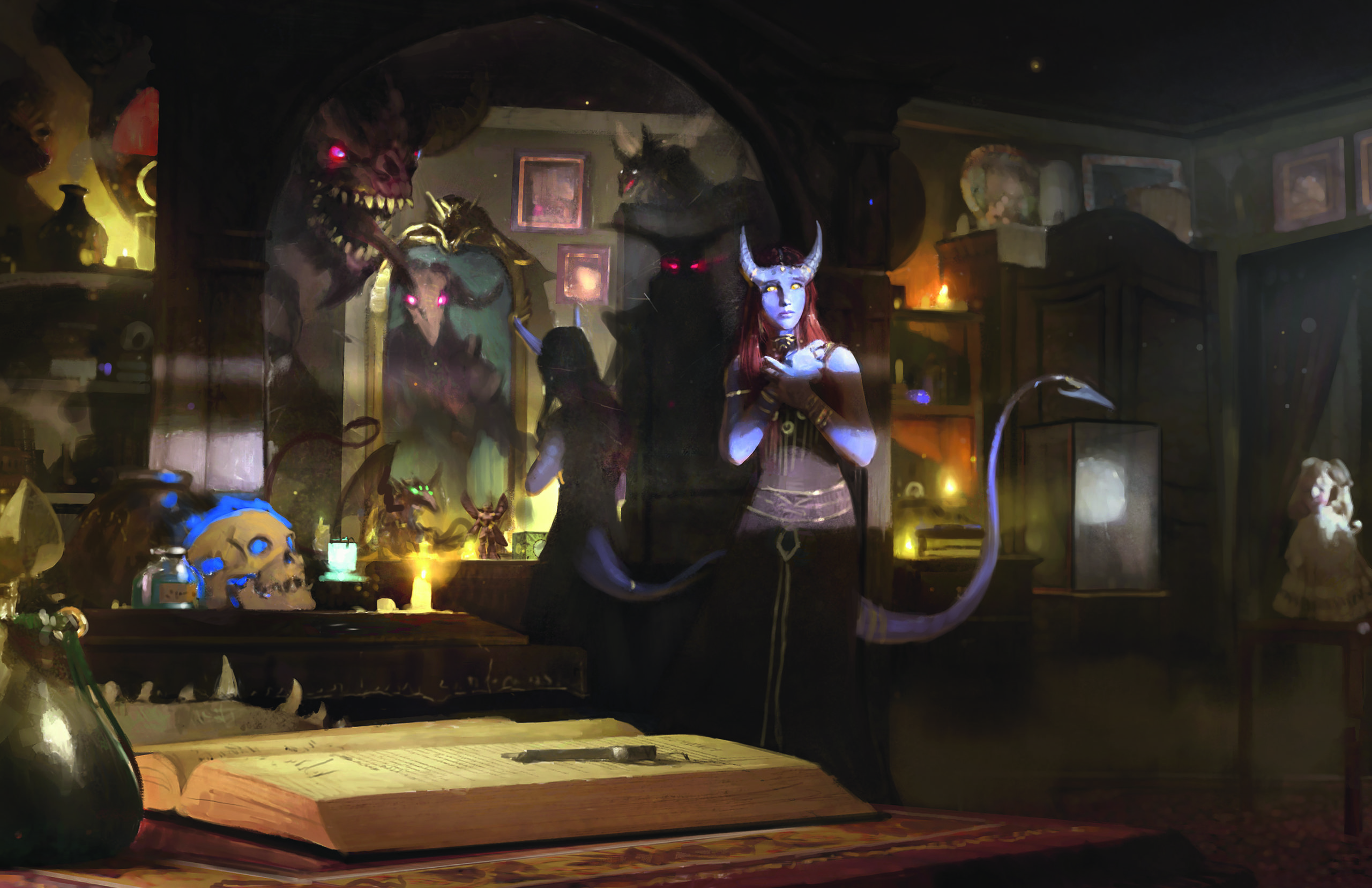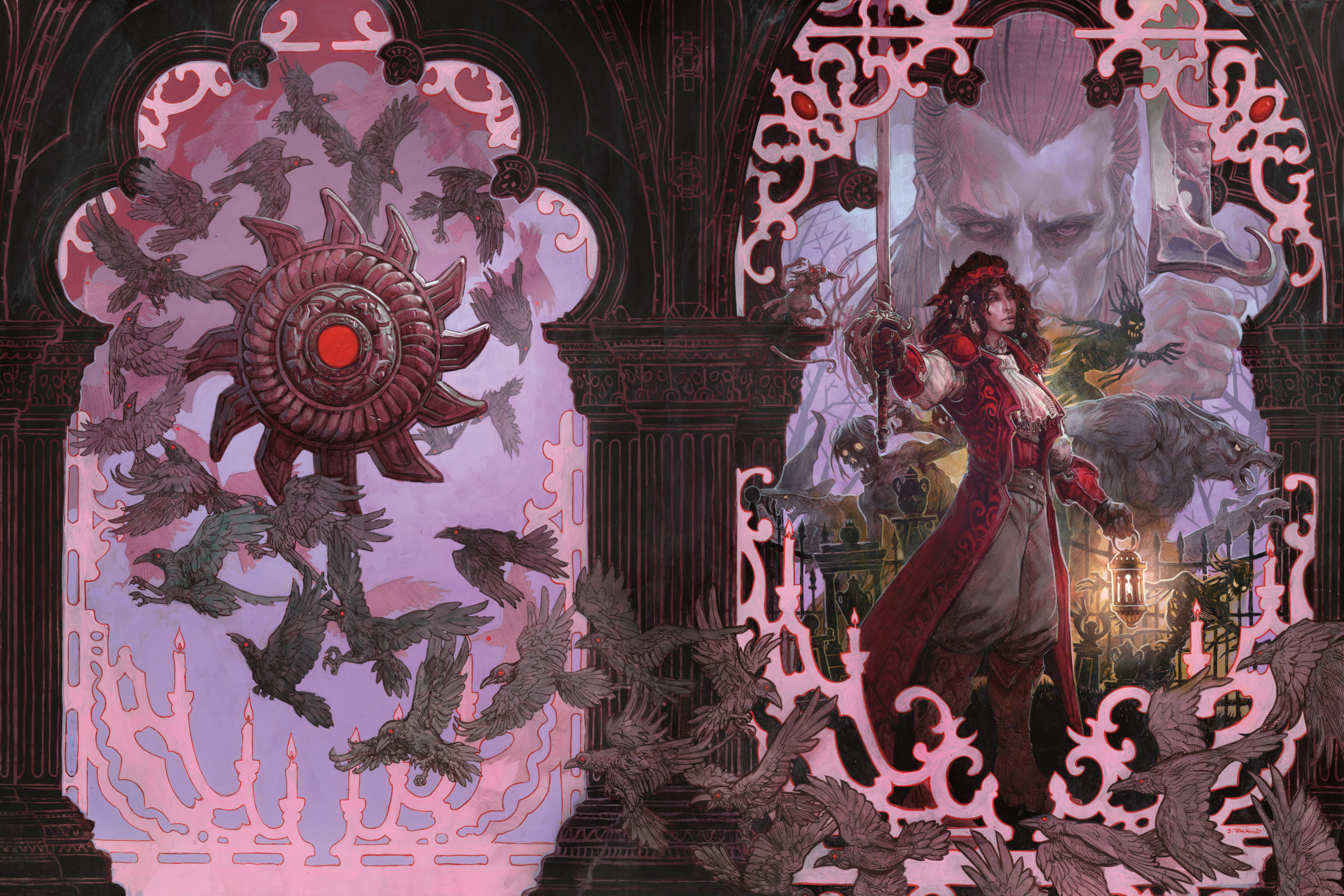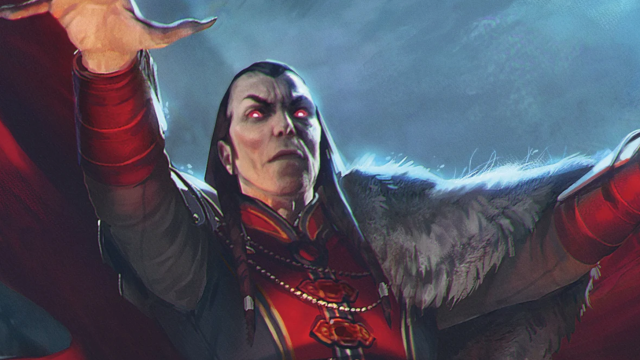Ravenloft is one of Dungeons & Dragons’ most iconic settings — its go-to source for all things spooky and horrifying. But, as iconic as figures like Strahd Von Zarovich and the gothic lands of Barovia are, they’re only one flavour of horror the plane has to offer. A new D&D campaign sourcebook wants to open up new avenues for the genre on our tabletops.
The next sourcebook for Dungeons & Dragons’ Fifth Edition, due out in May, is called Van Richten’s Guide to Ravenloft. It’s meant to be a resource for players to run horror-themed adventures across the dread domains of one of the most beloved planes of existence in the game’s fiction: the titular Ravenloft. The locale was first introduced in the Advanced Dungeons & Dragons module of the same name in 1983, and frequently returned to in D&D’s myriad iterations ever since, including Fifth Edition’s own The Curse of Strahd adventure. It’s become the epitome of what horror means to D&D — and the two are forever linked in the gothic aesthetic, vampires, ghouls, dark nights, and spooky castles.
[referenced id=”1663884″ url=”https://gizmodo.com.au/2021/01/dungeons-dragons-new-adventure-book-brings-fresh-voices-to-the-forgotten-realms/” thumb=”https://gizmodo.com.au/wp-content/uploads/2021/01/13/ooj4nsye4ro7ctj76t5x-300×300.jpg” title=”Dungeons & Dragons’ New Adventure Book Brings Fresh Voices to the Forgotten Realms” excerpt=”Typically, a Dungeons & Dragons adventure book is all about creating a world for your heroes to go on epic campaigns — detailing the vast settings of places like Eberron or Icewind Dale, or setting up cities like Waterdeep or even the Magic: The Gathering land of Ravnica. While its…”]
But while Ravenloft is in the name of Van Richten’s, the book doesn’t want to be strictly limited to what fans know of D&D’s prior forays into horror. Instead, it aims to provide resources to take adventurers beyond the lands of Barovia mined in Curse of Strahd and across many other lands in the Dempilane of Dread.
“Just like how the original Ravenloft adventure was spread out into an entire campaign setting back in the ‘90s, we’re doing very much the same thing [in Van Richten’s],” Wes Schneider, a Senior Game Designer on Wizards of the Coast’s D&D team and one of the key architects behind the new book, told press in a recent briefing. “We’re starting with the core of Curse of Strahd and then expanding out from there into other domains of dread — and beyond just gothic horror. So, we’ll also be seeing cosmic horror, ghost horror stories, dark fantasy, psychological horror — all these different things depending on what your favourite flavour of nightmare might be.”
Infamous vampire hunter Dr. Rudolph Van Richten may be the titular star of the new book, but Van Richten’s Guide will give players information on a bevy of characters to populate each of the over 30 domains of dread that are detailed in the book, both potential allies on excursions and existential foes — like the Darklords that rule each land in Ravenloft. “Ravenloft has always been so much about the characters, the stories that are really the roots of the various domains of dread,” Schneider explained. “One of the most significant ways of seeing that is that every one of these different domains — just like how Barovia has Strahd — all of the others also have their own Darklord. So, there are these supervillains that are really not just the core motivator behind the plots of domains, but also a prisoner of those places. But then, by the same token, just like Van Richten, we have a whole spectrum of different monster hunters that are trying to fight against the dark in their various ways — whether that’s being detectives, monster hunters, investigators…so on and so forth.”
That means there’ll be familiar faces for players who’ve already run Curse of Strahd, or for those who’ve been following the deep lore of Ravenloft as a setting across decades of adventures and novels, as well as entirely new characters being introduced for Van Richten’s Guide. “We’re going to see a return of Ezmerelda d’Avenir from Curse of Strahd, but then we’ve also got other characters like the master detective Alanik Ray, he’s a detective — has a whole detective agency and whatnot for your more urban horror and occult stories, but you’ve also got the Weathermay-Foxgrove Twins who are a pair of twins who studied under Van Richten now out on their own — sort of a vampire-hunter/werewolf hunter pair,” Schneider teased. “There’s a few surprises in there as well for some folks who are familiar with the old Ravenloft. Because there’s some characters that were previously hinted at, or in the past, that we’ve now decided ‘No, you’ve been around — you get your own story.’”
But Schneider was also quick to stress that Van Richten’s Guide is not a sequel to Curse of Strahd, where players must be intimately aware with its characters and story before diving into the material…unless seasoned adventure groups want it to be. “We’re very cognisant of the fact that there will be players who played through that, who know there are things in Curse of Strahd, that are streamlined in the new text, as well,” Schneider added.
Instead, the focus of Van Richten’s Guide is on fleshing out the myriad other realms in Ravenloft’s demiplane for adventurers to play in beyond the mist-covered gothic lands of Barovia. Each section covering a different “Domain of Dread,” as they’re known, not only details important characters like the sinister Darklord who rules over them but provides basic premises for adventure hooks there. The intent with each domain was also to provide a different kind of horror genre for gamers to play with, beyond Barovia’s spin on classic gothic fiction. “We really wanted to show off the vast spectrum of what you can do with horror,” Schneider stressed, “because the old Ravenloft was very much gothic horror. And gothic horror is very much part of this, but, like I was saying, we’re really casting the net wide, so any type of horror [adventure] can be run here.”
[referenced id=”1670975″ url=”https://gizmodo.com.au/2021/02/avatar-heads-to-rpgs-lord-of-the-rings-goes-there-and-back-again-and-more-gaming-news/” thumb=”https://gizmodo.com.au/wp-content/uploads/2021/02/10/duaddew8ukul8bun9frh-300×169.png” title=”Avatar Heads to RPGs, Lord of the Rings Goes There and Back Again, and More Gaming News” excerpt=”Welcome back to Gaming Shelf, Gizmodo’s column all about board games and tabletop roleplaying games. This week, everything changes when the fire nation rolls for initiative, Magic: The Gathering celebrates Black History Month, and Games Workshop figures out another way to ease you into the worlds of Warhammer.”]
That means there are Ravenloft domains old and new that are getting twists and spins to present them as different sub-categories of the horror genre. Want a creepy dark fairytale realm to set a ghoulish masquerade in? Take your party to the realm of Dementlieu. Want political machinations as dark powers vie for control of the land in a never-ending war of dread? There’s Kalakeri, a new realm inspired by Indian folklore. Many of the realms already familiar to readers will be represented with new twists to take on a vibe of their own. The forested land of Valachan, for example, is now essentially D&D’s take on The Dangerous Game, as the Darklord hunts your party down for sport. Lamordia is now the realm of Dr. Viktra Mordenheim — presumably of relationship to Ravenloft’s Victor Mordenheim — a mad scientist dedicated to her craft of creating monstrous new flesh golems in an icy twist on Frankenstein.
The wildest reinvention of all might be Van Richten’s Guide’s version of Falkovnia: once similar to Barovia as a riff on vampiric horror, it’s now a full-on zombie apocalypse zone. “Falkovnia was always one of the places where the whole concept of ‘let’s bring these old domains back but really given them a new spin’ started coming from,” Schneider noted. “In the past, it was run by a character named Vlad Dracov, who was sort of Vlad the Impaler — that was sort of the whole domain’s schtick. Well, we’ve sort of got a Vlad-esque character with Strahd, already! So, with Falkovnia, this was one where there wasn’t really a good seed, so, what we ended up doing was when we updated it, it’s like, ‘Here’s a domain, it’s a cool setting, there’s a lot of cool places and whatnot’ — what’s the neat spin we can give it? So, we turned Falkovnia into our zombie apocalypse domain. Ravenloft had never had that before just because that’s not really a gothic horror trope. Now, we have this entire domain that’s constantly crumbling under the weight of these endless zombie invasions — and the new Darklord is a terrible character, but also sort of the domain’s last hope to survive against this even more overwhelming supernatural disaster.”

Taking what had grown in prominence in the modern horror genre and applying it to D&D formed a major spine for the work being done on Van Richten’s Guide. “How do you take all the elements of horror we know and love and are so pervasive now, but give a D&D spin to it?” Schneider asked. “So, like, if you just look at the zombie in the monster manual, even a first level party is going to be like, ‘Eh, zombie’ — but what happens when there’s more zombies than there are fireballs? And how does that affect an entire society, how does that affect the character? How do we make all these classic stories D&D?”
Tying all the different realms together in the book are a people who will be familiar to players who’ve ventured into Ravenloft before: the Vistani, who formed a major part of The Curse of Strahd’s setting. A nomadic culture, the Vistani provide a chance for adventurers to encounter people who have visited lands beyond the one their current story is taking place in. “You’re not generally going to run into Lamordians in Barovia, or the folks from Valachan — you could in isolated instances, but as a general throughline, these are characters you might run into again and again. Fundamentally, they are people who have a specific cultural experience,” Schneider said of the Vistani’s role in Van Richten’s Guide.
He was also quick to note that the book, like the recent revamp of Curse of Strahd, was consulted on by sensitivity readers and cultural experts to inform any worldbuilding to avoid playing on real-world cultural stereotypes, as had previously been the case with the Vistani’s roots in Romani culture. “A couple of different folks who were so generous with their time, absolutely fantastic with their insights, took all of that to heart and made sure to give the Vistani another look in a way I think folks are going to be really excited about.”
[referenced id=”1234693″ url=”https://gizmodo.com.au/2020/07/dds-culturally-sensitive-strahd-revamp-is-here-but-it-will-cost-you/” thumb=”https://gizmodo.com.au/wp-content/uploads/2020/07/28/iaxt8cbqq4kih4qixzjn-300×169.png” title=”D&D’s Culturally Sensitive Strahd Revamp Is Here, But It will Cost You” excerpt=”Over the years, Dracula-type villain which features the Vistani as a major supporting element.”]
Aside from information on all these established settings, Van Richten’s Guide will also give Dungeon Masters the tools to craft their own horrifying realm to tell a story in. “The domains that we present are, in a way, sort of examples for if you want to take a splash of gothic horror and you want to throw in some disaster horror, this is the domain that might come out of it, here’s your example for that,” Schneider added. “But we’ve done a whole chapter on ‘What is a domain?’ ‘What is a Dark Lord?’ ‘What is this specific secret sauce for making your own Domain of Dread?’ — What we do is go through a variety of genres of horror just being like, ‘Alright, these are some settings in this genre — these are what ghostly villains might look like, these are what body horror settings look like,’ so, to an extent, you can use that for inspiration or mix and match your own element, put them all together and then have a unique horror experience that you randomly generated. Or, if you wanted to make a more bespoke nightmare, you’ve got all the tools that you need.”
On top of that, in order to make the book’s material accessible, each of the domains described in its settings will be usable by adventure groups of various levels. “The settings are designed so you can run with really any sorts of adventures you want, of any level you want,” Schneider stressed. “There are certain domains where it’s like, “Alright, this is the domain where it’s much more higher magic and you’ve got wizards who are doing, like, amoral things and so on and so forth. You can skew in that direction, but it’s not prescriptive. There’s no ‘You must be this tall to ride this domain.’”
The guide’s far-ranging approach to horror also required a hefty cast of writers. “We worked with a ton of fantastic authors on all of this,” Schneider noted. “Just a few that come to mind — authors like Cassandra Khaw who recently came out with Nothing But Blackened Teeth — she’s a fantastically twisted horror author. Molly Ostertag who you might know from The Witch Boy and the other books in that series, she did some of the more folk-horror elements. K. Tempest Bradford who recently came out with The Copper Scarab, has been doing a lot of really cool stuff with sort of Egyptian-inspired settings. There’s a ton of other fantastic writers on this. I think everybody’s going to be really impressed when they see the list.”
[referenced id=”1509016″ url=”https://gizmodo.com.au/2020/09/a-glorious-space-brawl-kicks-off-cassandra-khaws-sci-fi-adventure-the-all-consuming-world/” thumb=”https://gizmodo.com.au/wp-content/uploads/2020/09/24/coer-book-300×173.png” title=”A Glorious Space Brawl Kicks Off Cassandra Khaw’s Sci-Fi Adventure The All-Consuming World” excerpt=”When a group of former crooks reunites for a rescue mission, they’ll need to battle a fierce AI and overcome their own differences if they hope to succeed. Gizmodo is thrilled to reveal the cover and an excerpt from Locus and British Fantasy Award-nominated short fiction writer Cassandra Khaw’s first…”]
One of those writers, D&D team member Amanda Hamon (who contributed to the new Barovia material), also helped Schneider bring together the guidelines for creating a new horror tale in the form of a brief adventure to flex the ideas laid out to players: House of Lament. “We’re gonna put it all together into a 20-page adventure called The House of Lament, which focuses on one of Ravenloft’s most notorious haunted houses,” Schneider teased. “The characters have reasons to come together at this house, and they meet up with some of the other heroes that we mentioned before and in the course of that, they start exploring this haunted house — and even conducting seances to reach out to the spirits of the house. Like so many classic haunted house stories, things go terribly wrong and players who spent all this time exploring the house, now all they want to do is escape.”
“I think I’m mostly excited for the House of Lament adventure and seeing what type of hauntings and weird things Wes was able to come up with,” Hamon added. “The horrible things that happen to adventurers coming out of Wes’s mind — because I’ve played horror games with that guy over there, and some of the stuff he’s done to our characters has been just horrifying. So, I’m really looking forward to that. We talked internally about how things work, and I think folks will be very, very excited to see how the world of Ravenloft comes together within a very classic haunted house environment.”
Hamon also expounded on the more mechanical side of things the book will delve into. Aside from the official arrival of two ‘Unearthed Arcana’ subclasses from Wizard’s playtesting initiative — the College of Spirits for Bards, and the Undead Patron for Warlocks — three new lineage options will allow players to role Dhampir, Hexblood, and Undead characters, either entirely from scratch or to incorporate the transformation of their current characters. If that wasn’t spooky enough, new “Dark Gifts” will give players options to tie their adventurer’s spiritual existence to the realms they’re visiting, having them be haunted by the ghouls and ghosts of the land.

“[Dark Gifts] are ways to connect your character to the specific realms that you’re playing, and they have mechanical benefits — but they’re also very, very flavorful and describe a bit about where your character is coming from and how your character is haunted,” Hamon explained. “The book is concerned with the idea that any horror story across any media is, at its core, about a haunting. What scares the character? What has happened to them? What are their hang-ups and the bad things that happen to them in the narrative? The Dark Gifts really reinforce that, and use mechanical elements to play the game and [facilitate] that sort of roleplaying.”
“I think one of the things that differentiate a horror game from a normal tabletop RPG is the high atmospheric environment you’re playing in. And I’m really excited Wes was able to build-in some of these mechanical ways so it’s not just describing a thing or being superficial,” Hamon added. “It really feels baked in and important.”
That same approach was what guided the inclusion of the new lineages as well, incorporating the choice to become these races over the course of a story. “We’re really excited to bring the dhampir to D&D because it is such an iconic piece of horror media — the dhampir has existed for a very long time in different iterations, so it’s super cool to be able to play a vampire-blooded creature that gets some of the pieces of being a vampire without actually being one,” Hamon explained. “There’s lots of ways — we include random options, or you can pick how your PC became a dhampir, the way the line [of a character’s lineage] became a dhampir — and they’re really creative. The things that jumped out at me reading it over, Wes has really come up with a lot of very cool creative backgrounds to seed in ideas players might not even think of.”
[referenced id=”1671662″ url=”https://gizmodo.com.au/2021/02/dungeons-dragons-novels-revisiting-the-wyverns-spur/” thumb=”https://gizmodo.com.au/wp-content/uploads/2021/02/12/xheeghd9pg0x6nv51rto-300×168.jpg” title=”Dungeons & Dragons & Novels: Revisiting The Wyvern’s Spur” excerpt=”The tale of the magically created sellsword and would-be assassin Alias and her boon companion, the saurial paladin Dragonbait, continues in the second volume of the Finder’s Stone trilogy — which, wait a minute…uh…doesn’t actually feature Alias or Dragonbait? At all. But I’ll tell you what The Wyvern’s Spur does…”]
In the case of the Hexblood lineage, it also gave the team the chance to do something that’s slowly been worked on in D&D material before: the option for player characters to choose a race that is usually only depicted as monstrous or antagonistic. “The Hexblood lineage is all tied to hags. There are a lot of players I know, specifically, really into hags and the mythology of hags — and this allows you to tie your character into a hag. You couldn’t normally play one because they’re monsters and meant to be opposed,” Hamon explained, “But what happens when your character has descended from, or been touched by — or otherwise has some connection to a hag, it’s a really cool thing. It’s a concept that comes from art and literature all the way back, so knowing that to be a playable thing in D&D is really a very fun thing and Ravenloft-esque mechanic for us.”
“There’s one other neat thing about these lineages, and that’s part of the reason we’re calling them lineages: they’re races characters can pick at first level but over the course of your campaign, if players want to experience picking up one of these lineages and changing from what they formerly were,” Schneider added. “Maybe they start out as an elf or dwarf — if in the course of your adventures you run into vampires or hags and it makes sense to mentally change your character, these lineages give you the opportunity.”
Van Richten’s Guide represents a foray into horror that is far more expansive and comprehensive than D&D has ever done before, touching on the genre beyond vampiric spooks as it has with Curse of Strahd. It’s a chance for the game to bring in horror fans to tell explicitly horror stories across multiple genres. But with that layer, it also brings new considerations for the team and for player groups alike.
[referenced id=”756731″ url=”” thumb=”” title=”” excerpt=””]
“Horror roleplaying games are very different from horror video games or movies. You don’t have the special effects, you’re not ever going to see a real ghost at the game table — unless you’re really lucky!” Schneider joked. “A horror role-playing game is much more personal, and much longer. It also doesn’t have an off switch. So, if somebody does get uncomfortable at the table — if it turns out that the DM’s whole story is about secretly the worst thing that ever happened in your life, what do you do with that? How do you avoid getting into that situation? How do you get out of it? And how do you make sure the game group is being supportive?”
As well as the tools to create spooky stories, Van Richten’s Guide will also include directions on how to run them safely and consensually. “[There’s] a lengthy discussion about, ‘Session Zero’ sort of discussions you can have with your group, safety tools you can have at the table, ways that you can edit the game on the fly — ways to support your players, the DM included, in being upfront about, ‘Hey, we’re going to run this sort of adventure — these are going to be the features of it,’” Schneider explained. “All of this advice is great for horror, absolutely, but it’s also great for any game. Because you never know when something might make an unexpected turn. If your group could be supportive, that doesn’t just make a better game, but it also keeps friends.”

It also means providing storytelling options that don’t necessarily lean on the more gruesome aspects of horror, to be more mindful of D&D’s ever-growing audience. “We understand many folks these days play with their kids, younger players — horror doesn’t need to mean an R-rated movie. It doesn’t need to mean adults only. You don’t need to bring your parents with you to see this D&D experience,” Schneider added. “Horror can be cartoons like Scooby-Doo or the old Ghostbusters cartoon — those sort of things have horror elements to them while also being action stories, adventure stories, mystery stories suspenseful stories…it doesn’t need to be all gory and visceral. So a ton of what we talk about is how to make a horror experience that’s right for you.”
But even as it explores horror roleplaying — a genre already well established on the tabletop even as D&D has barely officially touched it beyond Ravenloft — Van Richten’s Guide always brings it back to the source material of the Forgotten Realms themselves. “Cosmic horror is super popular for example, it’s definitely something we want to explore, but we want to explore it in the context of D&D — so yes, if you want investigators haunting down various squamous terrors and whatnot, by all means,” Schneider said of Fifth Edition’s foray into the horror field. “There’s a lot of discussion on how you can do those spooky investigator detective campaigns, totally a place for that. But we wanted things to feel D&D.”
“There’s tons of horror games out there. They are amazing. They do very specific things fantastically. We are not interested in aping those other games. We want to be D&D.”
Van Richten’s Guide to Ravenloft will release on May 18.
